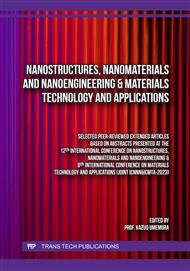p.35
p.43
p.55
p.63
p.69
p.79
p.85
p.95
p.103
Experimental Characterisation of BGBC OTFT for Indoor CO2 Gas Sensing
Abstract:
Global warming is a concern nowadays due to excessive release of harmful gasses to the environment, leading to greenhouse effect phenomena worldwide. Based on the data provided by global pollution agencies, the release of greenhouse gasses to the atmosphere is the main cause of pollution and the increase in atmospheric temperature due to warming. Greenhouse gasses (GHGs) contents released to the environment is worrying, with carbon dioxide (CO2) is reported at the highest concentration compared to other gasses. There are many studies conducted to develop and evaluate the performance of harmful gas sensors incorporating inorganic and organic semiconductive materials. Organic semiconductors (OSCs) are environmentally friendly materials, relatively cheaper technology, and comprised of a wide range of materials with good carrier mobility. Therefore, in this work, Organic Thin Film Transistor (OTFT) is developed for gas sensor application. As global warming is becoming more serious, this solution is instead a sustainable solution to the environment, as organic molecules which are held together via Van der Waals bond are easily processed via low-temperature deposition and solution processing as compared to more complicated processes involved in conventional inorganic counterpart. In addition, the developed sensor is generally robust due to the ability to withstand high humidity conditions and can be fabricated on flexible substrates. In this work, suitable materials are identified in basic OTFT construction, which are the electrodes, dielectric and substrate. The scope is mainly focusing on the development of bottom gate OTFT construction, incorporating p-type active material which are Trisisopropylsilylethynyl Pentacene (TIPS Pentacene), Aluminium (Al) as drain and source electrodes, PEDOT: PSS as gate electrode and Polyvinyl alcohol (PVA) as gate dielectric. The materials in bottom gate bottom contact (BGBC) configuration, fabricated via screen printing technique is experimentally tested towards CO2 detection. CO2 is initially detected at 1618 ppm with contact resistance of 15 kΩ, and at 10 ml/minute flow rate, the developed configuration is demonstrated able to achieve sensitivity of 2.069 Ω/ppm. In conclusion, the studied BGBC OTFT has demonstrated suitability and applicability in CO2 gas sensing for sustainable environmental condition monitoring, that could lead to safer environment for the living things on earth. With the proposed dimensions, in the future it is possible to proceed with this work to be fabricated by using more advanced techniques such as photolithography and many others.
Info:
Periodical:
Pages:
69-77
Citation:
Online since:
March 2024
Keywords:
Price:
Сopyright:
© 2024 Trans Tech Publications Ltd. All Rights Reserved
Share:
Citation:



